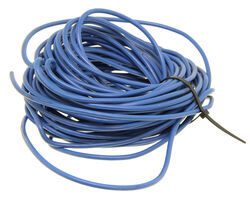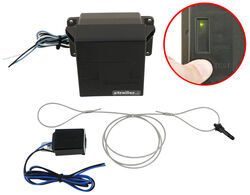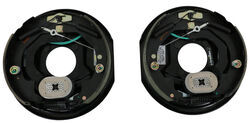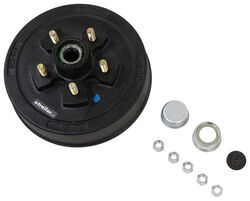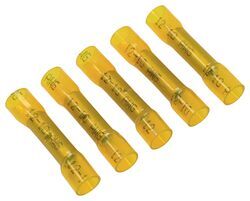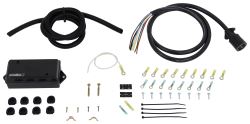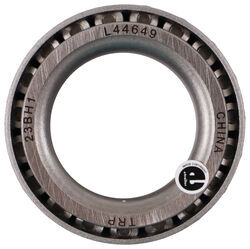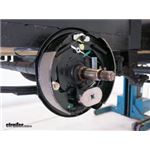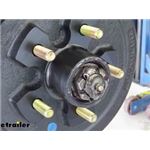
Parts Needed to Add Electric Drum Brakes to a 16 Dual Axle Trailer
Question:
I have a 16 ft. duel axle utility trailer with no brakes at the present time. what parts do i need to install them.second question do i need brakes on both sides. could you please enter what parts you recommend, it also has 14 inch wheels with 5 hole lugs. 4 3/4 thank you
asked by: Jim
Expert Reply:
To install electric brakes on your trailer you need brake mounting flanges, brake assemblies, hub and drum assemblies, trailer wiring for the brakes, a breakaway kit, and a brake controller installed in your vehicle.
You do want to install brakes on both sides of the axle(s) otherwise your trailer will pull to one side when your brakes are applied. We also recommend installing brakes on all of the axles that you have on your trailer. This helps to ensure that you have enough stopping power, plus it keeps your brakes from wearing down quicker.
I can make some recommendations for you but you need to confirm that the parts will fit before getting them.
It sounds like you have 3,500 lb axles and 14" wheels with a 5 on 4-1/2" bolt pattern (see attached article). If this is the case then I recommend the following part numbers in the following quantities:
Brake Mounting Flange - # 4-35 (for a 2-3/8" round axle) (4)
Brake Assemblies - # AKEBRK-35-SA (2)
Hub and Drum Assembly - # AKHD-545-35-EZ-K (2)
Breakaway Kit # 20099 (1)
Trailer wiring would include the Trailer Wiring 7-Way Upgrade Kit # HS381-9000 along with 10 Gauge Wire # 10-1-1 and Butt Connectors # DW05745-5.
To ensure that the hub and drum assembly is the correct fit for your spindle you need to pull the hub and verify that your inner bearing is part # L68149, your outer bearing is part # L44649, and that your grease seal has a 1.719" inner diameter.
I have attached some helpful articles and videos to assist.

Products Referenced in This Question
Hopkins Engager Push-To-Test Trailer Breakaway Kit w/ Built-In Charger - Side Load - 7" Wire
- Trailer Breakaway Kit
- Kit with Charger
- Side Load
- Single-axle
- Tandem-axle
- LED Tester
- Hopkins
more information >
etrailer Electric Trailer Brakes - Self-Adjusting - 10" - Left/Right Hand Assemblies - 3.5K
- Trailer Brakes
- Electric Drum Brakes
- Standard Grade
- Self Adjust
- 10 x 2-1/4 Inch Drum
- 3500 lbs Axle
- etrailer
more information >
Easy Grease Trailer Hub and Drum Assembly for 3.5K Axles - 10" - 5 on 4-1/2 - Pre-Greased
- Trailer Hubs and Drums
- Hub with Integrated Drum
- Easy Grease
- EZ Lube
- Pre-Greased
- L68149
- L44649
- For 3500 lbs Axles
- 1/2 Inch Stud
- 5 on 4-1/2 Inch
- 13 Inch Wheel
- 14 Inch Wheel
- 14-1/2 Inch Wheel
- 15 Inch Wheel
- etrailer
more information >
Deka Heat Shrink Butt Connector - 12-10 Gauge - Nylon Insulation - Yellow - Qty 5
- Wiring
- Wire Connectors
- Butt Connectors
- 12-10 Gauge
- Deka
more information >
Wiring Kit for Hydrastar Electric Over Hydraulic Actuators
- Accessories and Parts
- Brake Actuator
- Disc Brakes
- Hydraulic Drum Brakes
- Wiring
- Hydrastar
more information >
Replacement Trailer Hub Bearing - L44649
- Trailer Bearings Races Seals Caps
- Bearings
- Standard Bearings
- 1.063 Inch I.D.
- Bearing L44649
- Race L44610
- 3500 lbs Axle
- etrailer
more information >
Replacement Trailer Hub Bearing - L68149
- Trailer Bearings Races Seals Caps
- Bearings
- Standard Bearings
- 1.378 Inch I.D.
- Bearing L68149
- Race L68111
- 3500 lbs Axle
- etrailer
more information >
Product Page this Question was Asked From
Brake Mounting Flange for 2-3/8" Round Axle
- Accessories and Parts
- Trailer Brakes
- Disc Brakes
- Electric Drum Brakes
- Hydraulic Drum Brakes
- Brake Mounting Flange
- 10 Inch
- 2-3/8 Inch Diameter Axle
- Redline
more information >
Featured Help Information
Instructions
Miscellaneous Media

Continue Researching
- Article: Parts Needed to Add Electric Drum Brakes to a Trailer
- Article: Trailer Wiring Diagrams
- Article: Parts Needed to Add Hydraulic Disc Brakes to a Trailer
- Q&A: Demco vs. etrailer Hydraulic Dacromet 3,500 lb Trailer Brakes
- Q&A: Recommendation for Installation of a Brake Mounting Flange on a Trailer Spindle and Axle
- Q&A: Recommended Disc Brake System for Salt Water Boat Trailer with Tandem Axles
- Article: How to Tell the Weight Rating of a Trailer Axle
- Q&A: 86-1/2 Inch Long Axle Option For Grand Design Trailer
- Article: Adding Electric Over Hydraulic Disc Brakes
- Q&A: Leaf Spring Recommendation for 4,400 lb Trailer Axle
- Article: 5 Tell-Tale Signs It’s Time to Replace Your Trailer’s Leaf Springs
- Article: How to Replace Trailer Leaf Springs in 5 Steps
- Q&A: Recommended Wet Bolt and 2-1/4" Shackle Strap Kit for Tandem Axle Trailer
- Q&A: Do I Need Brakes On Both Axles of a Car Hauler Trailer?



